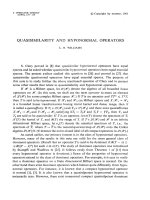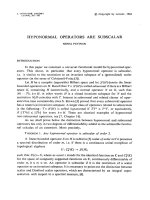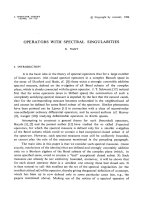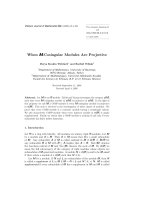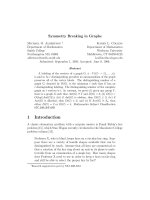Báo cáo toán học: "Digraphs are 2-weight choosable" ppt
Bạn đang xem bản rút gọn của tài liệu. Xem và tải ngay bản đầy đủ của tài liệu tại đây (87.98 KB, 4 trang )
Digraphs are 2-weight choosable
Mahdad Khatirinejad
∗†
Reza Naserasr
‡
Mike Newman
§†
Ben Seamone
‡ ¶
Brett Stevens
‡ †
Submitted: Feb 21, 2010; Accepted: Jan 12, 2011; Published: Jan 19, 2011
Mathematics Subject Classifications: 05C22, 05C15
Abstract
An edge-weighting vertex colouring of a graph is an edge-weight assignment such
that the accumulated weights at the vertices yield a proper vertex colouring. If such
an assignment from a set S exists, we say the graph is S-weight colourable.
We consider the S-weight colourability of digraphs by defining the accumulated
weight at a vertex to be the sum of the inboun d weights minus the sum of the
outbound weights. Bartnicki et al. showed that ever y digraph is S-weight colou rable
for any set S of size 2 and asked whether one could show the same result using an
algebraic approach. Using the Combinatorial Nullstellensatz and a classical theorem
of Schur, we provide such a solution.
Let G be a simple graph with no isolated edge and S be a set of real numbers. An
S-edge-weighting of G is an assignment w : E(G) → S. The weigh ted degree of a vertex
is the sum of weights of the edges incident with it. If the weighted degrees of adjacent
vertices are different we say that w is an S-weight colouring, and we say that G is S-
weight colourable. Karo´nski et al. [KLT04] asked whether every graph is {1, 2, 3}-weight
colourable; they showed this is true for 3-colourable graphs. Kalkowski et al. [KKP09]
showed that general graphs are {1, 2, 3, 4, 5}-weight colourable. We generalize S-weight
colourings to directed graphs by defining the weighted degree o f a vertex of D to be the
sum of the inbound weights minus the sum of the outbound weights of that vertex. We
allow our digraphs to contain multiple parallel arcs in either direction, but no loops.
These problems have natural list-colouring variants. Suppose that each e ∈ E(G) of
a (directed) graph G is assigned a set of real numbers L
e
. Let L = ∪
e∈E(G)
L
e
. The
∗
Department of Communications and Networking, Aalto University, P.O.B ox 13000, 00076 Aalto,
Finland,
†
Partially supported by NSERC Canada.
‡
School of Mathematics and Statistics, Carleton University, Ottawa, Canada
{bseamone,brett}@math.carleton.ca
§
Department of Mathematics, University of Ottawa, Ottawa, Ca nada,
¶
Partially supported by Fonds qu´eb´ecois de la recherche sur la nature et les technologies.
the electronic journal of combinatorics 18 (2011), #P21 1
(directed) graph G is weight colourable from the lists {L
e
}
e∈E(G)
if G admits an L -edge-
weighting w so that w(e) ∈ L
e
for each e. A (directed) graph is k-weight choosable if it is
weight colourable for any collection of lists of size k.
Problem 1. Given a graph G, find the minimum k such that G is k-w eight ch oosable.
Problem 2. Given a digraph D, find the minimum k such that D is k-weight choosable.
Recently, the questions stated in Problems 1 and 2 were studied by Bartnicki, Grytczuk,
and Niwczyk [BGN09]. Using a method relying on permanents of matrices and Combi-
natorial Nullstellensatz, they determined many families of undirected graphs which are
3-weight choosable and thus determined classes of graphs for which the solution to Prob-
lem 1 must be k ≤ 3. Furthermore, they conjectured that every graph without an isolated
edge is 3-weight choosable.
Regarding digraphs, it is shown in [BGN09] that all digraphs are 2-weight choosable,
thus completely solving Problem 2. However, as their proof was algorithmic in nature,
they asked whether it was possible for their Combinatorial Nullstellensatz approach to be
extended to digraphs. We show that it is indeed possible by applying a classical theorem
of Schur. We also note a few interesting corollaries of this result which relate to both
graphs and digraphs.
We begin by presenting the two necessary tools for our proof – Combinatorial Null-
stellensatz [Alo99] and a classical theorem of Schur [Sch18] (see [Min78, Theorem 2.5, p.
26] for a proof of Schur’s theorem in English).
Theorem 1 (Combinatorial Nullstellensatz). Let F be an arbitrary field, and let f =
f(x
1
, . . . , x
n
) be a polynomial in F [x
1
, . . . , x
n
]. Suppose the total degree o f f is
n
i=1
t
i
,
where each t
i
is a nonnegative integer, and suppose the coefficient of
n
i=1
x
t
i
i
in f is
nonzero. If S
1
, . . . , S
n
are subsets of F with |S
i
| > t
i
then there are s
1
∈ S
1
, s
2
∈
S
2
, . . . , s
n
∈ S
n
so that
f(s
1
, . . . , s
n
) = 0.
Theorem 2 (Schur). If A is a positive semi-definite Hermi tian matrix, then per(A) ≥
det(A), with equality if and onl y if A is diagonal or A has a zero row.
We remind the reader that the permanent of an n × n matrix A = (a
i,j
) is defined by
per(A) =
σ∈S
n
n
i=1
a
i,σ(i)
,
where S
n
denotes the set of all permutations on {1, . . . , n}.
Theorem 3. Every digraph is 2-weig h t c hoosable.
Proof. Let D be a digraph with vertex set V (D) and arc set E(D). Let |E(D)| = m. We
use e
h
to denote the head of arc e, and e
t
to denote the tail of arc e.
the electronic journal of combinatorics 18 (2011), #P21 2
Assign a variable x
e
and a list L
e
of size 2 to each e ∈ E(D). To every vertex v of D,
we associate the term
P
v
=
e
h
=v
x
e
−
e
t
=v
x
e
,
that is, the sum of the variables of the inbound arcs minus the sum of the variables of the
outbound arcs. Define the real multivariate polynomial P
D
=
e∈E(D)
(P
e
h
− P
e
t
). Then
D is 2-weight choosable if and only if there exists an s
e
∈ L
e
for every e ∈ E(D) such
that P
D
(s
e
1
, . . . , s
e
m
) = 0.
Each monomial in P
D
has total degree m. We will show that the coefficient of
e∈E(D)
x
e
is nonzero and then the result follows from Theorem 1.
For every e ∈ E(D), we may write P
e
h
−P
e
t
=
e
′
∈E(D)
M
e,e
′
x
e
′
, where M is an m×m
matrix indexed by the arcs of D and defined by
M
e,e
′
=
2 if e
t
= e
′
t
, e
h
= e
′
h
,
−2 if e
t
= e
′
h
, e
h
= e
′
t
,
1 if e
t
= e
′
t
, e
h
= e
′
h
or e
h
= e
′
h
, e
t
= e
′
t
,
−1 if e
t
= e
′
h
, e
h
= e
′
t
or e
h
= e
′
t
, e
t
= e
′
h
,
0 otherwise.
We have P
D
=
e∈E(D)
e
′
∈E(D)
M
e,e
′
x
e
′
. Therefore the coefficient of
e∈E(D)
x
e
is
per(M).
Note that M = XX
t
, where X is the m × n vertex-arc incidence matrix of D, that is
X
e,w
equals 1 if e
t
= w, −1 if e
h
= w, and 0 otherwise. Furthermore, XX
t
is diagonal if
and only if no two edges are incident, in which case the result holds trivially. Otherwise,
XX
t
is a positive semi-definite matrix that is neither diagonal nor has a zero row, and
so by Schur’s theorem we have per(M) = per(XX
t
) > det(XX
t
) ≥ 0. Thus, the desired
coefficient is nonzero.
The 2-weight choosability of digraphs not only solves the problem of 2-weight coloura-
bility of digraphs (Problem 2), but it also yields the following interesting results which
are not, at first glance, weight choosability problems.
Corollary 4. Every graph G has an orientation D such that the weighted degrees of D
give a proper vertex colouring of G.
Proof. Let D
′
be any orientation of G. Let L
e
= {−1, 1} for each e ∈ E(D
′
) in Theorem 3.
The digraph D obtained from D
′
by swapping the direction of those arcs with weight −1
gives the desired result.
Note that in the vertex colouring guaranteed by the above result, the parity of the
colour assigned to a vertex will be the same as the parity of its degree. This implies that
the number of colours used to colour a d-regular graph via Corollary 4 is at most d + 1,
which is one more than the number of colours guaranteed by Brooks’ Theorem in the case
of non-complete graphs which are not odd cycles and precisely the chromatic number if
G = K
n
or G = C
2n+1
.
the electronic journal of combinatorics 18 (2011), #P21 3
Corollary 5. Every digraph D has a subgraph F such that the weighted deg rees of F give
a proper vertex colouring of D.
Proof. Let L
e
= {0, 1} for each e ∈ E(D) in Theorem 3.
References
[Alo99] Noga Alon. Combinatorial Nullstellensatz. Combin. Probab. Comput., 8(1-2):7–
29, 1999. Recent trends in combinatorics (M´atrah´aza, 1995).
[BGN09] Tomasz Bartnicki, Jaroslaw Grytczuk, and Stanislaw Niwczyk. Weight choos-
ability of graphs. J. Graph Theory, 60(3):242–256, 2009.
[KKP09] Maciej Kalkowski, Michal Karonski, and Florian Pfender. Vertex-coloring
edge-weightings: Towards the 1-2-3-conjecture. J. Combin. Theory Ser. B,
100(3):347–349, 2010.
[KLT04] Michal Karo´nski, Tomasz Luczak, and Andrew Thomason. Edge weights and
vertex colours. J. Co mbin. Theory Ser. B, 91(1):151–157, 2004.
[Min78] Henryk Minc. Permanents. With a foreword by Marvin Marcus, Encyclopedia
of Mathematics and its Applications, Vol. 6. Addison-Wesley Publishing Co.,
Reading, Mass., 1978.
[Sch18] I. Schur.
¨
Uber endliche Gruppen und Hermitesche Formen. Math. Z., 1(2-
3):184–207, 1918.
the electronic journal of combinatorics 18 (2011), #P21 4
